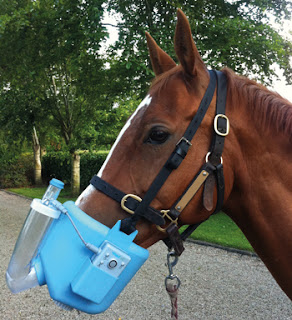Basil is back on his Dilateral Syrup for a few days. This helps him with his breathing because at this time of year he often has problems. In past years he has had quite bad attacks and I have had to call the vet to give him an injection of drugs to help him breathe. The attacks seem to come on very suddenly with little warning.
As we move into spring Basil gets swollen just where his head meets his neck, his lymph nodes, this swelling tends to come and go but I now know it is a sign that he needs to have some help breathing. He seems to be allergic to some type of pollen, or many types, but he is worst and has had most of his attacks at the end of May/early June.
So, for the last 3 years I have used a prevention method and given him a helping hand to prevent any attacks, he was alright last year, so I have my fingers crossed for this year! The vets have told me it is a type of Recurrent Airway Obstruction, this is most often seen as a result of dust from hay or straw bedding. However, Basil does not suffer in the winter and always seems better in the spring/summer after spending a few hours in the stable - so I have concluded it is a pollen allergy. He does not show any other symptoms of an allergy; he doesn't shake his head or anything, it is just his breathing that is affected.
To explain a bit more I thought I would use a blog post I wrote a while ago:
Recurrent Airway Obstruction
What is it
RAO is common, it limits performance and is an allergic respiratory disease. There are 2 forms of RAO in horses one which is associated with stabled horses which are fed hay and also summer pasture associated RAO seen in pasture kept horses.
Signs
·
Respiratory
difficulty
·
Flared
nostrils
·
Heave
line:- When the abdominal muscles help with breathing they can increase in size
and so leading to the heave line.
·
Rapid
breathing
·
Laboured
expiration
·
Wheezing:-
occurs when the air is flowing through narrowed airways.
·
Crackles:-
due to excessive mucus production.
·
Chronic
cough
·
Nasal
discharge
·
Cough
during feeding or exercise
·
Loss
of performance
Causes
Usually seen when susceptible horses are exposed to common allergens. It is thought to be the lungs hypersensitivity to inhaled allergens. These are often mould or dust found in straw or hay but can be a certain type of pollen, often oil seed rape is the culprit. The small airways become inflamed and narrow, mucus is produced and these lead to the signs mentioned earlier.
Diagnosis
The average age at which a horse develops RAO is 9 years old. It can occur in any breed but there does seem to be a genetic susceptibility.
Usually RAO is diagnosed from a physical examination and the horse's history as there is little to be seen from blood tests. Radiographs may show changes to the diaphragm.
Treatment & Prevention
Environmental management is the most important treatment and preventative measure. This is a long term commitment as horses with RAO will always be susceptible. Horses that suffer only mildly can often be kept healthy without drugs.
The most common causes are dusts present in hay and straw. Sufferers should be kept at pasture as much as possible with fresh grass as the source of roughage. Round bale hay has been found to be particularly allergenic.
Horses with summer associated RAO should be kept in a dust free stable environment.
Corticosteroid can be given to reduce the pulmonary inflammation but these should be avoided in horses or ponies at risk of laminitis. Bronchodilators (eg: Ventipulmin) can relieve obstruction of the airways by relaxing the muscles around the walls of the airways. They can be given as powder in food or inhaled using a special mask.
Have you seen my last video 'One May Day' to my You Tube channel?
Horse Life and Love. Please check it out and SUBSCRIBE.
You can also follow me on Facebook, Instagram and Twitter for updates on Basil, Tommy and Daisy.
Until next time!
Jo




No comments:
Post a Comment